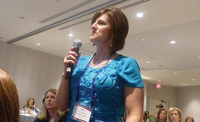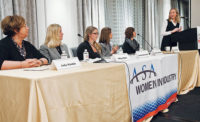The Texas A&M University industrial distribution program was a main focus during the recent ASA Women in Industry annual conference held in Austin, Texas.
During the morning session, Natalie Farr, president of the Professional Association for Industrial Distribution (P.A.I.D.) at the university, not only lent insight into the ID program (see the quarterly ASA Women in Industry column this month for more details), but also shared results of a recent survey of industrial professionals.
Farr, a recent graduate of Texas A&M, talked about the results of the “Women in Industrial Distribution: Emerging Opportunities and Challenges for Female College Graduates” survey. The study, which saw 293 individuals participate, examines challenges and opportunities facing females in industry. It was authored by Alicia Copeland (formerly of AD buying group member Standard Supply & Distributing in Dallas) and Dr. Malini Natarajarathinam, an associate professor in the ID program at Texas A&M.
Farr explained the survey shows most women agree there is a glass ceiling for them in industrial distribution, while most men agree there is not one for them. With gender stereotypes, the survey’s two highest among women include being labeled as too emotional and having experienced contributions or participation being discarded.
Research conclusions included a positive overall climate in industrial distribution, women feeling there is a glass ceiling present in the industry, women desiring a focus on training, manager skills and finding mentors, and women struggling with being placed more in “cost centers” than “revenue centers.”
Farr concluded her well-received presentation by talking about the next generation of professionals in the industry. “The more we understand the newer generations, the easier it will be to integrate everyone,” she said.
Farr encouraged employers to find out what is important to prospective employees (starting salary, time off, other benefits, etc.) and embrace the idea of internships. “Students are willing to give certain things up if a good opportunity exists whether that’s a great culture fit or the opportunity to move up,” she said. “It all depends on how you sell your company. Companies must sell themselves on why students would want to work for them.”
Concerning internships: “Interns are your best marketing strategy,” she said. “An intern program is a great way for students to see if they fit with a particular company. Internships don’t have to be a waste of money or a huge expense if you do them right. Having an intern sit behind the counter all day is not valuable. Having them do project-based tasks is more beneficial.”
Col. Mark Johnson, associate professor of practice in the ID program, also had some advice for companies. “Lay a path for these students where they will be two, three and five years down the road so they aren’t all leaving in 1.7 years,” he said. “They don’t want to leave a company. The company leaves them. Don’t be a company that leaves.”
In talking about the ID program at Texas A&M, Farr revealed a student in the program receives an average of 2.7 industry job offers, while in a spring 2016 salary survey, the average graduate’s salary was $56,317 (not including commission).
Elkay’s Michelle Brown and Sloan’s Mary Phelps later participated in a panel discussion with two Texas A&M ID students that covered a variety of topics. “Companies go through good times and bad times, but if the culture is always there, it will make you want to stay,” Brown said.
Attendees also heard from Amy Henry, who was a finalist on the first season of NBC’s “The Apprentice,” as well as from Austin businesswoman Nicole Patel, who told her story of starting a chocolatier business from scratch.
This year’s conference, in its fourth year, was attended by a record 150-plus women professionals. Next year’s conference heads to Savannah, Ga.
For more on the conference, turn to the ASA News and watch Mike Miazga’s interview with Natalie Farr in Austin.
This article was originally titled “Looking ahead” in the June 2017 print edition of Supply House Times.






